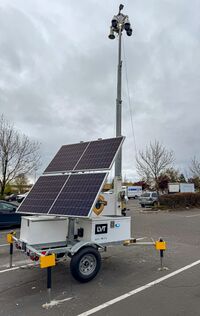LiveView Technologies AI Surveillance: Difference between revisions
1st draft |
No edit summary |
||
| Line 7: | Line 7: | ||
|ArticleType=Product | |ArticleType=Product | ||
|Category=Surveillance, Security, AI, Law Enforcement | |Category=Surveillance, Security, AI, Law Enforcement | ||
|Logo= | |Logo=LiveView_Technologies_security_trailer.jpg | ||
|Website=https://www.lvt.com | |Website=https://www.lvt.com | ||
|Description=AI-powered mobile surveillance towers that combine thermal imaging, behavioral analytics, and audio deterrence systems for 24/7 monitoring of public and private spaces without individual consent or warrants. | |Description=AI-powered mobile surveillance towers that combine thermal imaging, behavioral analytics, and audio deterrence systems for 24/7 monitoring of public and private spaces without individual consent or warrants. | ||
Revision as of 20:44, 25 August 2025
| Basic Information | |
|---|---|
| Release Year | 2005 |
| Product Type | Surveillance, Security, AI, Law Enforcement |
| In Production | Yes |
| Official Website | https://www.lvt.com |
LiveView Technologies (LVT) is a Utah-based surveillance company founded by Ryan Porter & Bob Brenner, operating over 6,000+ solar-powered mobile camera units across the United States. They generate $126 million in annual revenue.[1] The system, including the D3 Mobile Security Unit, combines AI-powered threat detection, thermal imaging, & "audio deterrence capabilities" & raise 4th Amendment & privacy concerns.[2]
Taxpayer impact summary
Freedom
Citizens have no way to opt out of LVT's surveillance network. The 22-foot towers monitor areas equivalent to eight football fields using thermal imaging that tracks movement at 1,200+ feet in complete darkness.[3] Unlike traditional security cameras that can be avoided, LVT's expanding network makes avoidance very difficult. The system uses "Agentic AI" to detect behaviors including loitering, PPE violations, & crowd gathering, with capabilities to operate in both overt and covert modes.[4]
Privacy
Data collected creates detailed movement patterns that reveal medical visits, religious attendance, political activities & personal associations. The system integrates with Axon Fusus, providing real-time feeds to police command centers & fusion centers.[5]
Fusion centers are controversial intelligence-sharing hubs created after 9/11 that operate in all 50 states; they facilitate data exchange between local, state, & federal agencies including DHS, FBI, & other intelligence organizations.[6] Originally intended for counterterrorism, these centers have expanded their scope to general crime surveillance, with the EFF warning they "could potentially be receiving unminimized NSA data," creating backdoor federal access to local surveillance.[7]
Business model
LVT operates on a subscription model charging $3,000-$3,750 monthly or approximately $45,000 annually per unit.[8]The company holds GSA contract #47QTCA23D00DN enabling streamlined purchasing by federal, state, and local agencies with a 20-year maximum ordering period.[9]
Market control
LiveView Technologies has achieved 100% compound annual growth over five years, raising $135 million from investors including Sorenson Capital.[10] The company's customers include private retailers Home Depot, Walmart, Kroger, Lowe's, Safeway, and Walgreens.[11] By targeting private sector deployments first, the company avoids public hearings typically required for municipal surveillance contracts.
Technology capabilities
Beyond simple cameras
LVT units, including the D3 Mobile Security Unit, combine multiple surveillance technologies:
- 22-foot telescoping masts with multiple cameras (panoramic, zoom, thermal)
- Thermal imaging tracking movement at 1,200+ feet in darkness
- PTZ cameras with optical zoom capabilities
- Microwave Doppler radar for motion detection
- Edge computing processing threats in under 1.5 seconds
- AI behavioral analytics detecting loitering, crowd formation, PPE violations
- Two-way audio loudspeakers for deterrence or remote announcements
- Solar power with battery backup for off-grid operation
- Optional Automatic License Plate Recognition (ALPR) integration
- Active deterrents: flashing strobe lights, floodlights, sirens, and automated audio alerts
The company advertises its units as autonomous "security guards" that can assess situations, deter trespassers, & escalate incidents to human operators when necessary, claiming a 0.5% false detection rate.[12]
AI & behavioral analytics
LVT's "Agentic AI" platform automatically detects and responds to perceived threats without human intervention.[13]
Incidents
Audio harassment incidents (2023-2025)
Playing loud music to annoy people into going away is a feature of these products, touted in LVT's blog:
Continuous, loud music: This solution is every parent's nightmare: loud music, ranging from "Baby Shark" to classical favorites, is played continuously to make it nearly impossible to sleep or reside in malls and outdoor retail spaces.... The next phase of security available from LVT mobile units is the auditory alert. Instead of continuous, loud music, the alert is temporary. It is also truly "alerting," making the area a terrible place to sleep for the night. Imagine the sounds of the worst hotel you've ever stayed at. Only worse.[14]
San Francisco Fillmore District
A Safeway store deployed an LVT unit that blasted classical music 24/7 for approximately one week at volumes so loud residents couldn't open windows.[15] The system played continuous loops of "Nutcracker" and "Swan Lake" until community pressure forced shutdown.[16]
Denver Home Depot
LVT representative Matt Kelley explicitly stated the harassment purpose: "People who hear the same looped soundtrack over and over tend to get a bit annoyed, so they vacate the area."[17]
Political surveillance (2024)
Monroe County, New York deployed LVT units to monitor Gaza war protests and demonstrations at legislature meetings.[18] Civil liberties attorney Scott Forsyth noted units could "peer inside" private offices and impact "protest activity, association activity, and being able to move about."[19]
Discriminatory placement complaints (2024)
LVT's own ACCESS Taskforce documented community concerns about discriminatory deployment, with one respondent noting a unit "set up in a primarily Black neighborhood where there were no businesses anywhere on the block," believing placement was racially motivated.[20]
Mankato surveillance controversy (2025)
While not specifically LVT units, Mankato, Minnesota's consideration of mobile surveillance trailers resulted in large public opposition. The city approved some AI surveillance upgrades but rejected mobile surveillance trailers & Flock cameras that would connect to national databases after heated community backlash over privacy concerns and the $130,000 cost.[21][22]
Constitutional challenges
While no specific Fourth Amendment challenges against LVT have been filed, legal experts warn the systems operate in a constitutional gray area. The Supreme Court's Carpenter v. United States decision established that long-term location tracking requires warrants.[23] Pending cases like Moore v. United States could establish nationwide precedent requiring warrants for prolonged camera surveillance.[24]
Civil liberties groups describe the visible 22-foot towers with flashing lights and automated warnings as contributing to an "Orwellian atmosphere" in communities where deployed.[25]
Security posture
No documented security vulnerabilities or data breaches have been found for LVT systems, distinguishing them from competitors:
- Verkada: Breach affecting 150,000+ cameras across Tesla, hospitals, schools, & police stations: $2.95 million FTC fine[26]
- Hikvision: 100+ million devices vulnerable, 80,000+ cameras unpatched[27]
LVT claims to operate "the only mobile surveillance provider with its own private cellular network" where data "never touches the public internet."[28] However, lack of independent security audits and references to addressing "potential vulnerability" in press releases raise questions about actual versus claimed security posture.
Crime reduction claims
The ACCESS Taskforce study reported a 73% reduction in weapons violations & 54% decrease in burglary/breaking and entering in Paducah, as well as a 40% decrease in shoplifting and 31% decrease in disorderly conduct in Opelika.[29] The study was conducted in Opelika, Alabama & Paducah, Kentucky, and analyzed by the Loss Prevention Research Council (LPRC), an industry-funded organization whose members include major retailers who are direct customers and partners of LVT.
The LPRC's funding structure creates direct conflicts of interest: the organization depends on membership fees from the very companies that benefit from positive security technology assessments. In this case, the study explicitly mentions retail partners participating in the ACCESS Taskforce (with details at LVT.com/access), meaning the evaluating organization (LPRC) is funded by companies with direct financial stakes in demonstrating the technology's effectiveness. This circular relationship—where customers help fund the organization that validates their vendor's products—undermines the study's independence and objectivity.
No peer-reviewed independent studies validate effectiveness claims.
Mission creep
LVT has expanded far beyond original construction site monitoring:
- Originally: Construction site theft prevention (2005)
- 2020: Retail parking lot surveillance
- 2021: School campus monitoring
- 2022: Border surveillance, environmental monitoring
- 2023: GSA federal contract obtained
- 2024: Protest and crowd management
- 2025: Integration with fusion centers
The company explicitly promotes units for "crowd management" at protests, stating they provide "the opportunity to get eyes on the protest, keep your officers safer, and optimize your personnel's efforts."[30] LVT acknowledges units can operate in both "overt" and "covert" modes, transforming visible deterrence into hidden surveillance.[31]
Data sharing and fusion centers
LVT's Axon Fusus integration enables data sharing across law enforcement agencies worldwide.[32] Through fusion center networks, surveillance data can flow to federal agencies including DHS and FBI.[33]
References
- ↑ "LiveView Technologies - Overview, News & Similar companies". ZoomInfo. Retrieved 2025-08-25.
- ↑ "New ACLU Report Reveals Alarming Growth of AI Video Surveillance Technologies". American Civil Liberties Union. 2024. Retrieved 2025-08-25.
- ↑ "AI-Driven Mobile Security for Every Threat". LVT. Retrieved 2025-08-25.
- ↑ "LVT Use Cases in Law Enforcement". LVT. Retrieved 2025-08-25.
- ↑ "LVT Launches Integration with Axon Fusus Real-Time Crime Center Technology". GlobeNewswire. 2025-04-23. Retrieved 2025-08-25.
- ↑ "Fusion Centers". Homeland Security. Retrieved 2025-08-25.
- ↑ "Why Fusion Centers Matter: FAQ". Electronic Frontier Foundation. 2014. Retrieved 2025-08-25.
- ↑ "Police surveillance trailer now 24/7 – Chico Enterprise-Record". Police surveillance trailer now 24/7 – Chico Enterprise-Record. Retrieved 2025-08-25.
- ↑ "LVT Granted MAS Contract From The General Services Administration". LVT. 2023-09-15. Retrieved 2025-08-25.
- ↑ "LiveView Technologies Secures $135M to Make Communities Safer and More Secure". LVT. 2024. Retrieved 2025-08-25.
- ↑ "LiveView Technologies". Wikipedia. Retrieved 2025-08-25.
- ↑ "Live Surveillance for Enhanced Security". LVT. Retrieved 2025-08-25.
- ↑ "AI-Driven Mobile Security for Every Threat". LVT. Retrieved 2025-08-25.
- ↑ "The Most Humane Battle: Know How to Prevent Homeless Encampments With LVT". LVT. Retrieved 2025-08-25.
- ↑ "SF Safeway blasted classical music 24/7 to 'deter loitering'". SF Gate. 2023. Retrieved 2025-08-25.
- ↑ "Safeway annoys SF neighbors with loud classical music. Here's why". San Francisco Chronicle. 2023. Retrieved 2025-08-25.
- ↑ "Denver businesses use loud music to fight crime, prevent loitering". 9News. 2023. Retrieved 2025-08-25.
- ↑ "Mobile cameras deployed at Monroe County Office Building amid security concerns". 13WHAM. 2024. Retrieved 2025-08-25.
- ↑ "Mobile cameras deployed at Monroe County Office Building amid security concerns". 13WHAM. 2024. Retrieved 2025-08-25.
- ↑ "The Role of Mobile Surveillance Units in Community Security". LVT. Retrieved 2025-08-25.
- ↑ "Public outcry at Mankato city council meeting regarding surveillance technology". KEYC. 2025-06-10. Retrieved 2025-08-25.
- ↑ "Public outcry continues over Mankato AI surveillance initiative". KEYC. 2025-06-24. Retrieved 2025-08-25.
- ↑ "The Fourth Amendment in the Digital Age". Brennan Center for Justice. 2024. Retrieved 2025-08-25.
- ↑ "Surveillance Technologies and Constitutional Law". PubMed Central. 2023. Retrieved 2025-08-25.
- ↑ "Surveillance Technologies". American Civil Liberties Union. Retrieved 2025-08-25.
- ↑ "FTC Takes Action Against Security Camera Firm Verkada". Federal Trade Commission. 2024-08. Retrieved 2025-08-25.
{{cite web}}: Check date values in:|date=(help) - ↑ "RCE Vulnerability in Hikvision Cameras". CISA. 2021-09-28. Retrieved 2025-08-25.
- ↑ "LiveView Technologies raises the bar for video surveillance". PR Newswire. 2022. Retrieved 2025-08-25.
- ↑ "LiveView Technologies Helps 2 Cities Reduce Crime". Police Magazine. 2023-08-22. Retrieved 2025-08-25.
- ↑ "LVT Use Cases in Law Enforcement". LVT. 2024. Retrieved 2025-08-25.
- ↑ "LVT Use Cases in Law Enforcement". LVT. 2024. Retrieved 2025-08-25.
- ↑ "LVT Integrates with Axon's Real-Time Crime Center Platform". GlobeNewswire. 2024-08-13. Retrieved 2025-08-25.
- ↑ "Fusion Centers". Homeland Security. Retrieved 2025-08-25.

